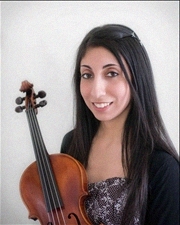Tutor HuntResources Violin Resources
Colour Keys - The Key To Teaching Keys To Young Violinists
A new resource for teaching key signatures to very young violinists
Date : 26/11/2013
Author Information

Uploaded by : Nandita
Uploaded on : 26/11/2013
Subject : Violin
Throughout the six years I have been teaching the violin, I have noticed that young children often find it very difficult to grasp the concept of key signatures. The beginner violinist is usually taught to play with the fingers in 'Finger Pattern 1' (0-1-23-4) on every string, which does not fall into any one key signature, so beginner pieces are usually carefully written to ensure they stick to the pattern and the issue of keys does not have to be broached. Once the pupil reaches a certain stage, they start learning scales, and at this point key signatures are introduced. Teaching a scale to a child is not particularly difficult - I find the younger pupils are usually very eager to learn their scales and often enjoy the process of learning the scale pattern, and there are many great books and resources available for teaching scales to children. However, I have found that even when scales have been learnt well, the pupil struggles to transfer the pattern of a certain scale into a piece in the same key, which shows that the pupil has not fully understood how the pattern works across the whole range of notes on the violin, and therefore cannot apply it when reading written notes, particularly when sight reading. This is such a frustrating and tedious process for both the pupil and teacher, and it is a major contributor to the moment of panic a pupil feels when faced with a piece of sight-reading.
The 'Colour Keys' method takes the process of learning keys apart so the pupil can build up a sense of each key in small steps to help them understand exactly what they are doing, how it feels and what it sounds like. There are four steps, using visual, kinesthetic and auditory methods of learning. The first step associates the key signature with the pattern first visually with a colourful finger pattern chart showing the pattern for all the strings in first position, and then aurally, by playing the whole pattern up and down slowly with the teacher. By taking into account the whole range of notes used in first position, not just those used in the scale, the pupil can start to see, hear and understand the finger placement for the whole key.
The second step is a series of short 'Play by Ear' exercises to introduce the idea of feeling and hearing the key. The exercises are very simple, as they are not aural training tests, they are designed specifically to reinforce the idea of the key being a whole pattern, and are intended to be repeated as many times as the pupil requires. These first two steps should enable the pupil to feel comfortable in a new key without the written notes getting in the way - once the muscles have got used to the feeling of a different finger pattern, the notes can be introduced.
In the third step, a series of short reading exercises, the pupil now has to use the finger pattern whilst reading the notes. The exercises are very simple so the pupil can think about the pattern they have learnt to feel and hear and apply it to the notes they can now see. However, the notes that are different to those in 'Finger Pattern 1' are coloured (co-ordinated with the colours of fingers in the finger charts), so there is a visual reminder that these fingers should be doing something different.
Finally, the fourth step is a short piece, which the pupil should prepare on their own. Simple articulation, dynamic and bowing markings make the piece more challenging and completing a whole piece gives the pupil the feeling that they have accomplished something positive at the end of the process. The three questions at the end of each chapter will show whether they have fully understood what they have learnt, and there is also a set of flashcards, which are helpful in learning to recognize key signatures.
Colour Keys is a fun and innovative way of teaching keys to young children, and for a teacher it is a great tool to help make the often challenging and frustrating process of teaching keys a little bit easier and lot more effective!
This resource was uploaded by: Nandita
